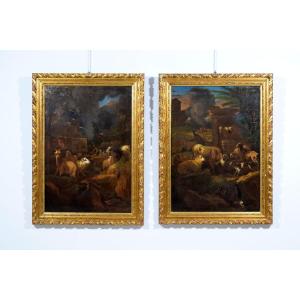Landscape of Italy with shepherds and a herd near a river or The passage of the gué
Oil on canvas Some restorations.
Rentoilage of the XIXth century. Recent cleaning
Important wooden frame and gilded plaster with canals
Considered one of the most important Dutch landscapers of the seventeenth century, Nicolas Berchem is especially fond of the colors of Italy. It is so true that, according to his biographer Arnold Houbraken, he would have done not one but two trips to Italy, and that he would have drawn the bulk of his inspiration from it. On his return to Amsterdam in 1653, a town he was not to leave until his death in 1683, he specialized in genre paintings, especially the rural ambiances he likes to decorate many animals whose anatomical rendering particularly in a way, constitutes his personal signature. Several versions, one fully autographed and the other attributed, are known from our painting. Returning to the collections of the Louvre Museum in 1795 after being part of the collections of the princes of Orange in The Hague, Le Bac or Le Passage du gué is a wooden work dating from the early 1660s (inv. 1040) . On this panel were placed peasants preparing to make their flock cross the other bank. In the distance, half-veiled by a mist which slowly dissipates, mountains rise from which stand the ruins of a medieval castle. Subsequently, this composition was engraved by Daudat and by Duplessis-Bertaux. From Belton House, Lincolnshire, where it belonged to Lord Brownlow, an oil on canvas with the same subject is attributed to Nicolas Berchem. After appearing on the rails of the gallery of the London merchant Alfred Brod, it is now part of the collections of the National Trust. The recent removal of the old varnish made it possible to see to what extent our painting presents strong chromatic similarities with the panel of the Louvre while the version of Belton House is moved away by a bias where the plays of light appear less sliced. The meticulousness with which the sheep, the mule and the herd have been represented reinforces the hypothesis. The idea that it was a copy after the engraving should therefore be excluded, especially since the restoration confirmed that the rudder was dated from the 19th century, probably from the first half. On the other hand, the original fabric presents a broad and irregular pattern, characteristic of the late 17th century and the first decades of the next century; which consequently precludes subsequent dating. It is therefore not impossible to think that our painting could have been painted directly in the studio of the master, who had many pupils, and that Berchem himself contributed to it.


































 Le Magazine de PROANTIC
Le Magazine de PROANTIC TRÉSORS Magazine
TRÉSORS Magazine Rivista Artiquariato
Rivista Artiquariato